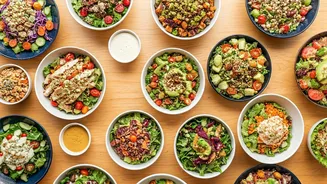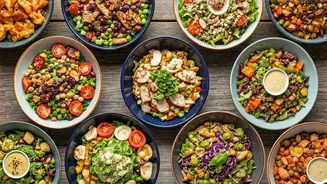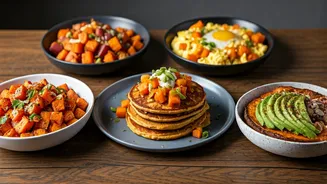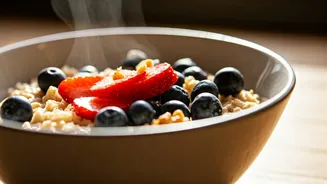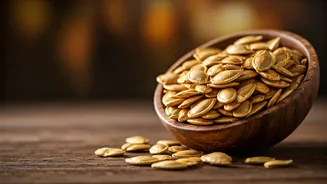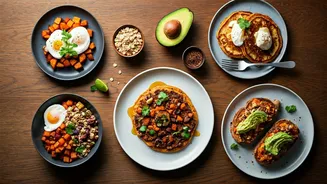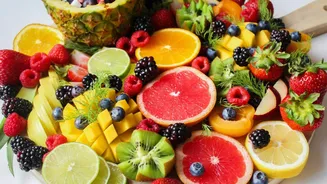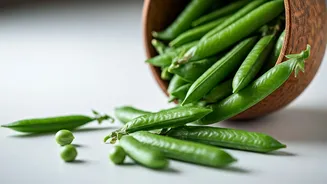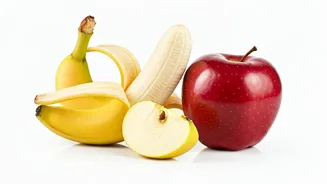Salads: A Healthy Start
Salads represent a cornerstone of healthy eating, offering a wealth of vitamins, minerals, and fiber. The beauty of salads lies in their adaptability,
allowing for endless combinations of ingredients to cater to individual preferences and dietary needs. Incorporating salads into your diet is a simple yet effective way to boost your overall health. They contribute to improved digestion, weight management, and can even enhance skin health. Choosing fresh, seasonal ingredients further maximizes the nutritional benefits. This foundation allows for exploration of various salad types, showcasing creativity and nutritional balance. From simple side dishes to complete meals, salads offer versatility and a path toward a healthier lifestyle. The benefits extend beyond just the nutritional aspects; salads also offer a delightful sensory experience, with a spectrum of colors, textures, and flavors that can invigorate the palate and promote mindful eating.
Classic Caesar Salad
The Caesar salad, a global favorite, showcases simplicity with its creamy dressing, crisp romaine lettuce, and crunchy croutons. The base typically consists of romaine lettuce, providing a refreshing crunch. The dressing is a key component, commonly made with olive oil, lemon juice, garlic, and Parmesan cheese, often incorporating anchovies for added umami flavor. The preparation typically involves tossing the lettuce with the dressing and topping with croutons and shaved Parmesan. Variations abound, including grilled chicken, shrimp, or even hard-boiled eggs for added protein. The balance of textures and flavors makes the Caesar salad a satisfying choice. For those watching calories, lighter dressing options, like Greek yogurt-based alternatives, are readily available. The Caesar salad’s adaptable nature makes it ideal for customization based on dietary requirements and personal tastes, making it a reliable and versatile meal option.
Greek Salad Delight
The Greek salad, also known as Horiatiki salad, is a refreshing combination of fresh vegetables and tangy flavors. The salad's core components include ripe tomatoes, cucumbers, red onions, bell peppers, Kalamata olives, and feta cheese, all dressed in a simple olive oil and vinegar dressing. The tomatoes provide sweetness, while the cucumbers contribute a cooling effect. Red onions offer a sharp bite, and bell peppers introduce a touch of sweetness. The Kalamata olives, known for their distinct taste, provide a salty, briny flavor that complements the other ingredients. The feta cheese, a cornerstone of the Greek salad, provides a creamy and salty counterpoint. It is typically served without lettuce and is often enjoyed as a refreshing appetizer. Its simplicity and balanced flavors have made it a popular dish worldwide, celebrated for its fresh and vibrant taste.
Caprese Salad Elegance
The Caprese salad, an Italian classic, celebrates the simplicity of fresh ingredients and vibrant flavors. This salad typically consists of slices of fresh mozzarella, ripe tomatoes, and fresh basil leaves, dressed with olive oil and balsamic glaze. The key to this salad is the quality of the ingredients: ripe, juicy tomatoes, creamy mozzarella, and fragrant basil leaves. The tomatoes provide a burst of sweetness, while the mozzarella offers a creamy texture. The basil adds a fresh, aromatic element. The balsamic glaze, adds a touch of sweetness and acidity. The Caprese salad is not only delicious but also visually appealing with its bright colors. It's often enjoyed as a light appetizer or side dish, and its simple preparation makes it accessible for cooks of all levels. The beauty of this salad lies in its minimalist approach, showcasing the natural flavors of the ingredients.
Spinach Salad Variations
Spinach salad provides a foundation for numerous variations. Spinach, being a nutritional powerhouse, offers a subtle earthy flavor. Popular additions include strawberries, raspberries, or mandarin oranges for sweetness, combined with nuts like almonds or walnuts for crunch. The dressing can range from simple vinaigrettes to creamy options with poppy seeds or honey. Hard-boiled eggs and crumbled bacon provide added protein and texture. Grilled chicken or shrimp can transform a spinach salad into a complete meal. The versatility of spinach allows for seasonal adjustments, pairing well with fruits and vegetables that are in season. The salad's simplicity makes it a great choice for quick lunches or light dinners. Customizing the dressings and toppings provides the freedom to create a balanced meal tailored to individual preferences and nutritional needs. This flexibility makes spinach salad a reliable and adaptable option for any time of year.
Cobb Salad Creation
The Cobb salad is a substantial and satisfying salad originating from the United States. It's a combination of greens, grilled chicken, bacon, hard-boiled eggs, tomatoes, avocado, chives, and blue cheese, with a classic vinaigrette dressing. The grilled chicken or chicken provides a lean protein source, while the bacon introduces a salty, smoky flavor. The hard-boiled eggs contribute additional protein and creaminess, while the tomatoes add sweetness and acidity. The avocado introduces healthy fats and a smooth texture. The chives and blue cheese introduce distinct flavors. The vinaigrette dressing ties all the components together. Cobb salads offer a complete meal, providing protein, healthy fats, and a variety of vitamins and minerals. The vibrant combination of flavors and textures makes it a delightful choice for lunch or dinner.
Pasta Salad Pleasures
Pasta salads offer a versatile and filling option. They typically combine cooked pasta with various vegetables, cheeses, and a dressing. Popular additions include cherry tomatoes, cucumbers, bell peppers, olives, and feta cheese. The dressing can be as simple as olive oil and vinegar or more elaborate, like a creamy pesto. The choice of pasta can also vary; rotini, penne, and farfalle are popular options. Adding protein, such as grilled chicken, chickpeas, or tuna, can enhance the nutritional value of the salad. Pasta salads are perfect for picnics, potlucks, or meal prepping. They can be prepared in advance, allowing the flavors to meld. The adaptability of pasta salads makes them an excellent way to use leftover ingredients and accommodate dietary preferences.
Quinoa Salad Options
Quinoa salads present a nutritious and protein-rich alternative. Quinoa, a complete protein, offers a subtle nutty flavor. These salads often feature vegetables, such as cucumbers, tomatoes, and bell peppers. Adding black beans, corn, or avocado boosts both taste and nutritional value. Lemon-herb vinaigrettes often complement quinoa salads. Variations may include adding grilled vegetables or incorporating roasted sweet potatoes for added sweetness. Quinoa salads are gluten-free and can be easily customized with various spices and herbs. They're an excellent choice for those seeking a healthy and filling meal, providing sustained energy and essential nutrients. This adaptability makes quinoa salads suitable for different diets and preferences.
Fruit Salad Delights
Fruit salads provide a refreshing and naturally sweet option. They commonly include a variety of fresh fruits, like berries, melons, and citrus fruits. Adding a touch of mint or a drizzle of honey enhances the flavors. Tropical fruit salads with mango, pineapple, and papaya offer a unique taste. For a richer texture, you can include yogurt or cottage cheese. Fruit salads can be enjoyed as a dessert, a snack, or as a light breakfast option. The variety of colors and flavors makes them visually appealing and a treat for the taste buds. Choosing seasonal fruits ensures maximum flavor and nutritional value. The combination of sweetness, vitamins, and antioxidants makes fruit salads a healthy and delightful choice.
Tips for Great Salads
Creating exceptional salads requires attention to a few key details. Selecting fresh, high-quality ingredients is paramount. Washing and drying your greens properly ensures they are crisp and flavorful. Experimenting with different textures, like crunchy nuts, creamy cheeses, or chewy grains, elevates the experience. Dressing the salad just before serving preserves the crispness of the ingredients. Making dressings from scratch allows for customization, and adjusting the seasoning to your taste. Don’t be afraid to try new combinations and add interesting ingredients, such as herbs and spices. Using a variety of colors enhances the visual appeal. Planning ahead, and preparing ingredients in advance, makes salad preparation quick and easy. With these tips, you're well-equipped to create salads that are both healthy and delicious.
Salads for Health
Salads are excellent for overall health, especially for weight management and digestive health. The high fiber content found in vegetables promotes satiety, which can help control appetite. Furthermore, the diverse vitamins, minerals, and antioxidants contribute to a stronger immune system and reduce the risk of chronic diseases. They can improve skin health and provide a balanced intake of various nutrients. By providing a base of essential nutrients, salads help boost your overall well-being. Including salads in your diet can be a stepping stone towards a balanced and healthy lifestyle. From helping manage weight to providing a wealth of nutrients, salads are a simple way to invest in your health. The versatility allows you to customize them to meet your specific dietary needs.
Salad Dressing Insights
The dressing is crucial to a salad's flavor, enhancing the ingredients. Vinaigrettes, with their oil and vinegar base, add acidity and flavor. Creamy dressings, like ranch or Caesar dressing, introduce richness and creaminess. The balance of acidity, oil, and flavorings is the key to a good dressing. Experimenting with homemade dressings allows you to control ingredients and adapt to your tastes. Store-bought dressings can be a convenient alternative. Keep in mind that less is often more, and a light dressing coats the ingredients without making them soggy. When making your own dressings, start with good-quality olive oil and a flavorful vinegar. Seasoning with herbs, spices, salt, and pepper can add depth. Choose dressings that complement your chosen salad ingredients.
Easy Salad Recipes
Many easy salad recipes are accessible, even for novice cooks. A simple mixed green salad with a vinaigrette is a great starting point. Pre-washed greens and pre-cut vegetables streamline the preparation process. Consider a basic Caprese salad (tomato, mozzarella, basil) or a Greek salad (tomatoes, cucumbers, olives, feta). A simple chopped salad with a basic dressing and any vegetables you enjoy is a customizable option. Canned beans or pre-cooked chicken make for quick protein sources. Use recipes as a guideline, and adapt based on what you have on hand. Don't be afraid to experiment with different combinations of ingredients. The goal is to make a flavorful salad with minimal effort. These simple recipes can provide a quick and healthy meal anytime.
Adding Protein to Salads
Adding protein to salads transforms them into filling meals. Grilled chicken or fish are excellent sources of lean protein. Hard-boiled eggs offer both protein and convenience. Chickpeas, lentils, and black beans provide plant-based protein, adding fiber and nutrients. Nuts and seeds, like almonds and sunflower seeds, contribute protein and healthy fats. Tofu, whether firm or silken, can be a versatile addition, absorbing flavors well. These proteins add substance to the salad, helping you feel satisfied. Consider the flavor profile when choosing protein to ensure that it complements other ingredients. A protein-rich salad can provide long-lasting energy and supports muscle health. Protein boosts nutritional value while making salads a full and complete meal.
Salad Meal-Prep Ideas
Meal prepping salads saves time during the week. Prepare ingredients in advance, like washing and chopping vegetables, cooking protein, and making dressings. Store each component separately to prevent sogginess. Layering ingredients in containers, starting with the dressing, followed by hearty vegetables, protein, and lighter toppings, keeps them fresh. Pre-made salad kits from the supermarket can also save time. Rotate salad ingredients to keep your meals interesting and to ensure balanced nutrition. Pack individual portions for lunches. By following a meal-prep approach, you can have healthy salads ready to go, saving both time and promoting healthier eating habits. This can help you stick to your dietary goals.
